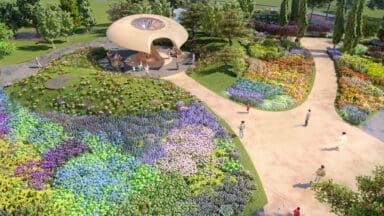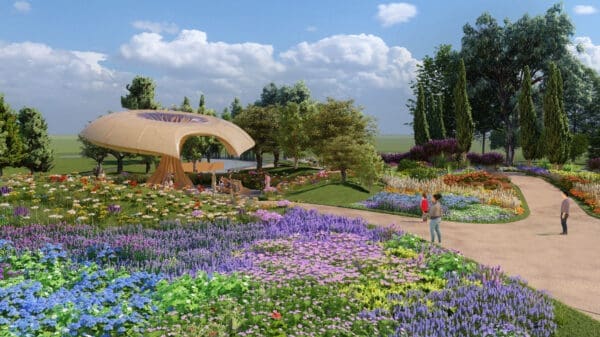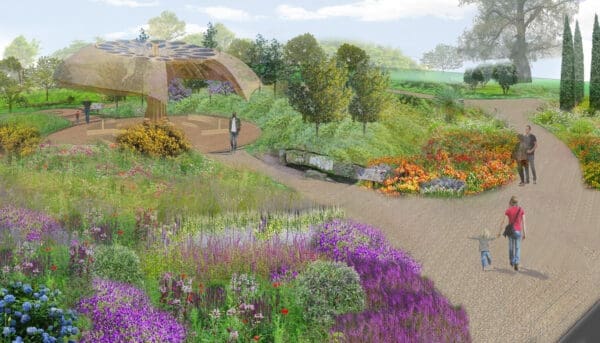
Designed as a permanent new garden within the Royal Botanic Gardens, Kew, the Carbon Garden aims to reveal the invisible, bringing to life the critical role carbon plays in sustaining life on Earth, communicating the scale of the climate crisis, and sharing the extraordinary potential of the natural world to combat it. The Carbon Garden hopes to encourage visitors to become advocates for nature, highlighting actions all can take in our everyday lives to support the health of plants and the planet.
Carbon is found in all living things. It exists in the air, it is dissolved into our oceans and rivers, it exists in organic matter in soils and is stored deep underground in sedimentary rocks and fossil fuels. While human activities have released an alarming amount of carbon into the atmosphere, trapping heat and warming the planet, plants and fungi continue to be natural allies in climate repair, capturing carbon and able to restore balance.
Aiming to be a powerful visual statement, the new Carbon Garden at Kew is designed to highlight the connection between plants and fossil fuels. Inspired by climate stripes (Professor Ed Hawkins, University of Reading in 2018) a striking display of herbaceous perennials will show vividly how global average temperatures have risen over time.
A dry garden showcases ways of working together with plants to adapt to a changing climate. Drought-tolerant and Mediterranean plants from hotter climates dominate, providing a contrast to the vivid herbaceous planting.
Approximately 26 new trees will be planted, selected for their resilience to projected future climate conditions. Trees play a critical role in helping urban areas adapt to climate change thanks to the ecosystem services they offer, including absorption of carbon dioxide, shade and shelter provision, and improvement of air quality by filtering out pollutants. A rain garden and bioswale illustrate ways to manage water flow, prevent soil erosion, reduce flooding, recharge moisture into the soil and support moisture-tolerant plants that maintain soil stability and carbon storage. Grasslands, wildflower meadows and native hedgerows will boost biodiversity, as biodiverse habitats are more resilient and better at storing carbon than monocultures.
Mimicking a symbolic fungal fruiting body, a central pavilion designed by Mizzi Studio is inspired by the symbiotic relationship between the plant and fungal kingdoms. The Pavilion will be created using low-carbon, natural materials. The forward-tilted canopy directs rainwater into the rain garden, and provides a sheltered space for school visits and community activities.



Richard Wilford, designer of the Carbon Garden and Manager of Garden Design at RBG Kew said: “The Carbon Garden offers a unique opportunity to showcase our ongoing research, combining scientific insight with thoughtful design and beautiful planting to highlight the role of carbon in our lives, how it moves through the environment and how plants and fungi can help us tackle climate change. We hope the Carbon Garden inspires visitors to act and join us in shaping a more sustainable, resilient future for life on our planet.”
Funding for the Carbon Garden was provided by Biffa Award through the Landfill Communities Fund and the People’s Postcode Lottery.
“We are immensely proud to support the Carbon Garden, which will educate and inspire visitors about the vital role of carbon in our environment. Through the Landfill Communities Fund, we are committed to funding projects that have a lasting positive impact on both people and the planet. We are particularly excited that this garden will not only showcase Kew’s research but will also serve as a hub for learning, demonstrating how collective action can drive real environmental change. Biffa Award is honoured to play a role in bringing this vision to life,” said Rachel Maidment, Biffa Award Grants Manager.

